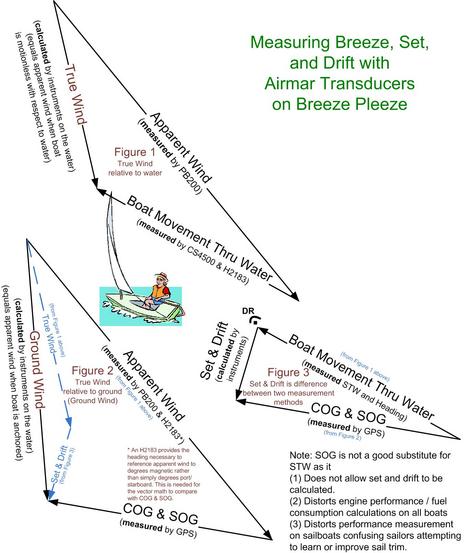AWS and AWD are far more important for sailing than either TWS or TWD.
Respectively, I must disagree. True wind speed and direction are what nature is giving you and is not affected by a moving vessel's course or speed (through the water, over the water... irrelevant.)
We use true wind information to navigate.
Apparent wind speed and direction is you affecting nature. Your boat's speed and direction changes the way you feel the true wind....that direction and speed you feel become altered.... that's why it's called APPARENT. Because AWD and AWS are the factors the boat senses when it's moving,
we use apparent wind information to trim, or manage, our sails.
Both are important, both are used whether you have instruments or not. You can't leave the dock without knowing which way the wind is blowing. You can't plan a route, or get around a buoyed course without knowing the true wind direction. You make reefing decisions based on true wind speed, not how fast your boat is moving.
When we're optimizing performance we need to watch our apparent wind information to adjust the sails... we can do that by monitoring the sail's telltales, watching the boat's flag, feeling the hair on the back of our necks... that's apparent wind.
Detecting changes in true wind direction..... lifts and headers... can be done by paying attention to your boat compass when sailing close hauled. Averaging your course directions on port and starboard when sailing close hauled will give you true wind direction (assuming current is minimal). Tracking those headings will tell you about wind shift patterns. That's what racing compasses do, btw. The headings are put into memory, with each new one compared to the previous to detect patterns.
IMHO, knowing your true wind speed and direction is much MORE important because it affects the decisions you make. Those decisions will, in turn, affect the boat's apparent wind information... and it's constantly changing with each course change, or change in sail trim. You could say the apparent info is telling us what we are doing. But there is nothing we do that influences the true data... that's nature telling us what we can or can't do.
Oh well... just my thoughts.


 , as I've had a cheep handheld for a few years but the batteries always seem to be dead and I don't know that I trusted it's accuracy anyway. but then you just don't get high quality for $15.00 like back in the good old days
, as I've had a cheep handheld for a few years but the batteries always seem to be dead and I don't know that I trusted it's accuracy anyway. but then you just don't get high quality for $15.00 like back in the good old days